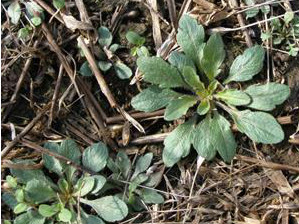
Marestail

(sometimes Horsetail) Equisetum arvensae
Fam equisetaceae
I have no shortage of this 'herb' (some would call it a weed), and I suppose that eventually I will have weeded it out. Its long black stringy roots are difficult to spot during the spring digging; they go very deep into the ground and can travel huge distances, so it will take a while to get rid of. Truth is, I don't want it *all* to go, because I do use it.
Last year, although the weather was dry, the soil was always damp under the brussels sprouts, where the equisetum was forming a diminutive prehistoric forest. In the evening and morning, drops of water could be seen in quantity on the equisetum. Did the plants draw water from greater depths to provide it with the damp environment it prefers, or was it condensation? I don't know, but the sprouts benefitted from the moisture, and I harvested the herbs!
The German name for equisetum is Zinnkraut - tin herb, because due to its high silica content, it can be used for scouring and polishing pewter and fine woodwork.
A cup of horsetail tea a day is recommended as a general strengthener and as a preventative and cure for urinary problems, as well as enriching the blood and hardening the fingernails. Again, this is one of the herbs descrbed in great detail by Maria Treben. (see bibliography in the library)
In the garden, equsetum can be made into a spray for the prevention and cure of plant problems which usually come about due to damp, warm conditions, like mildew and moulds. Spray susceptible plants fraquently whenever weather conditions could produse these problems. Use 1kg fresh or 150gm dried equisetum in 10 litres of water, then dilute one in five before spraying.
![]()

The Castle

Brigid's Garden

Moyra's Web Jewels